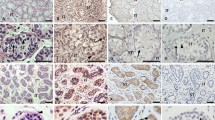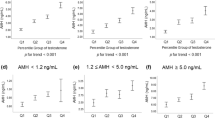Abstract
REGRESSION of Müllerian ducts in male foetuses is mediated by a testicular factor distinct from testosterone1. This anti-Müllerian hormone (AMH), a protein which has been partially purified2, is synthesised by foetal Sertoli cells3. In mammals the first stage of testicular differentiation involves the arrangement of sustentacular or Sertoli cells around the gonocytes and their encasement in testicular cords. Leydig cells appear later in the interstitium and their differentiation is correlated with the onset of steroidogenesis. We thought that there might also be a correlation between the initiation of testicular anti-Müllerian activity and the differentiation of Sertoli cells. Little work has been done on anti-Müllerian activity of the early foetal testis. During the initial stages of testicular organogenesis in the rat4 and the guinea pig5, AMH production is low, but the rapid pace of sex differentiation in most rodents hampers sequential study. Using sows (Sus scrofa), we have avoided this problem, and confirmed that the correlation exists.
This is a preview of subscription content, access via your institution
Access options
Subscribe to this journal
Receive 51 print issues and online access
$199.00 per year
only $3.90 per issue
Buy this article
- Purchase on Springer Link
- Instant access to full article PDF
Prices may be subject to local taxes which are calculated during checkout
Similar content being viewed by others
References
Jost, A. Arch. anat. morph. exp. 36, 271–315 (1947).
Josso, N., Picard, J. Y. & Tran, D. Rec. Prog. Hormone Res. 33, 117–160 (1977).
Blanchard, M. G. & Josso, N. Pediat. res. 8, 968–971 (1974).
Picon, R., C. r. hebd. Séanc. Acad. Sci., Paris 271, 2370–2372 (1970).
Price, D. Am. Zool. 15, Suppl. 1, 173–195 (1975).
Pelliniemi, L. J. & Salonius, A. L. Acta anat. 95, 558–564 (1976).
Picon, R. Arch. anat. micr. morph. exp. 58, 1–19 (1969).
Josso, N., Forest, M. G. & Picard, J. Y. Biol. reprod. 13, 163–167 (1975).
Bross, I. D. Biometrics 14, 18–38 (1958).
Ben-David, M., Heston, W. E. & Rodbard, D. J. natn. Cancer Inst. 42, 207–218 (1969).
Pelliniemi, L. J. Am. J. Anat. 144, 89–112 (1975).
Moon, Y. S. & Hardy, M. H. Am. J. Anat. 138, 253–268 (1973).
Martoja, R. & Martoja-Pierson, M. Initiation aux Techniques de l'Histologie Animale 116 (Masson, Paris, 1967).
Raeside, J. I. & Sigman, D. M. Biol. reprod. 13, 318–321 (1975).
Meusy-Dessolle, N. C. r. hebd. Séanc. Acad. Sci., Paris 278, 1257–1260 (1974).
Josso, N. Biol. Neonate 20, 368–379 (1972).
Franchimont, P., Chari, S., Hagelstein, M. T. & Duraiswami, S. Nature 257, 402–404 (1975).
Tindall, D. J., Vitale, R. & Means, A. R. Endocrinology 97, 636–648 (1975).
Author information
Authors and Affiliations
Rights and permissions
About this article
Cite this article
TRAN, D., JOSSO, N. & MEUSY-DESSOLLE, N. Anti-Müllerian hormone is a functional marker of foetal Sertoli cells. Nature 269, 411–412 (1977). https://doi.org/10.1038/269411a0
Received:
Accepted:
Issue Date:
DOI: https://doi.org/10.1038/269411a0
This article is cited by
-
Molecular mechanisms underlying AMH elevation in hyperoestrogenic states in males
Scientific Reports (2020)
-
Altered testicular development as a consequence of increase number of sertoli cell in male lambs exposed prenatally to excess testosterone
Endocrine (2013)
-
Postnatal development of bovine Sertoli cells
Anatomy and Embryology (1986)
-
Effect of serum on organogenesis of the rat testis in vitro
In Vitro (1984)
-
Ultrastructural study of Sertoli cells in rat seminiferous tubules during intrauterine life and the postnatal period
Anatomy and Embryology (1980)
Comments
By submitting a comment you agree to abide by our Terms and Community Guidelines. If you find something abusive or that does not comply with our terms or guidelines please flag it as inappropriate.



